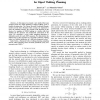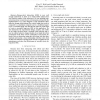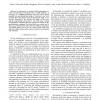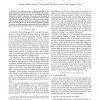IROS
2008
IEEE
14 years 6 months ago
2008
IEEE
— In this paper, we present a new method that uses random search for online planning of biped walking, given a feasible footstep plan. The Linear Inverted Pendulum dynamic model ...
IROS
2008
IEEE
14 years 6 months ago
2008
IEEE
— This paper proposes a computational model for phoneme acquisition by infants. Human infants perceive speech sounds not as discrete phoneme sequences but as continuous acoustic ...
IROS
2008
IEEE
14 years 6 months ago
2008
IEEE
— This paper proposes a method for augmenting the information of a monocular camera and a range finder. This method is a valuable step towards solving the SLAM problem in unstruc...
IROS
2008
IEEE
14 years 6 months ago
2008
IEEE
Abstract— In this paper we show that, despite some disadvantageous properties of radio frequency identification (RFID), it is possible to localize a mobile robot quite accuratel...
IROS
2008
IEEE
14 years 6 months ago
2008
IEEE
— Human-robot interaction (HRI) is now well enough understood to allow us to build useful systems that can function outside of the laboratory. We are studying longterm interactio...
IROS
2008
IEEE
14 years 6 months ago
2008
IEEE
Abstract— In this paper we present initial experiments towards environmental monitoring with a mobile platform. A prototype of a pollution monitoring robot was set up which measu...
IROS
2008
IEEE
14 years 6 months ago
2008
IEEE
— We present a probabilistic architecture for solving generically the problem of extracting the task constraints through a Programming by Demonstration (PbD) framework and for ge...
IROS
2008
IEEE
14 years 6 months ago
2008
IEEE
— This paper provides a detailed analysis of the motion planning subsystem for the MIT DARPA Urban Challenge vehicle. The approach is based on the Rapidly-exploring Random Trees ...
IROS
2008
IEEE
14 years 6 months ago
2008
IEEE
Abstract— In the framework of physical Human-Robot Interaction (pHRI), methodologies and experimental tests are presented for the problem of detecting and reacting to collisions ...
IROS
2008
IEEE
14 years 6 months ago
2008
IEEE
— We present the motion planning framework for an autonomous vehicle navigating through urban environments. Such environments present a number of motion planning challenges, incl...




